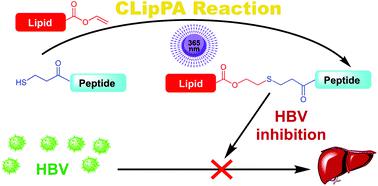当前位置:
X-MOL 学术
›
Org. Biomol. Chem.
›
论文详情
Our official English website, www.x-mol.net, welcomes your
feedback! (Note: you will need to create a separate account there.)
Thiol–ene enabled preparation of S-lipidated anti-HBV peptides
Organic & Biomolecular Chemistry ( IF 2.9 ) Pub Date : 2020-11-06 , DOI: 10.1039/d0ob01997f Oscar A Shepperson 1 , Alan J Cameron , Carol J Wang , Paul W R Harris , John A Taylor , Margaret A Brimble
Organic & Biomolecular Chemistry ( IF 2.9 ) Pub Date : 2020-11-06 , DOI: 10.1039/d0ob01997f Oscar A Shepperson 1 , Alan J Cameron , Carol J Wang , Paul W R Harris , John A Taylor , Margaret A Brimble
Affiliation

|
Despite significant efforts made towards treatments for Hepatitis B virus (HBV), a long-term curative treatment has thus far eluded scientists. Recently, the Sodium Taurocholate Co-Transporting Polypeptide (NTCP) receptor has been identified as the entry pathway of HBV into hepatocytes. Myrcludex B, an N-terminally myristoylated 47-mer peptide mimic of the preS1 domain of the Hepatitis B virion, was identified as a potent protein–protein interaction (PPI) inhibitor blocking HBV fusion (IC50 = 140 pM). Herein we report an optimised chemical synthesis of Myrcludex B and a series of novel analogues. Employing a small modification to the Cysteine Lipidation of a Peptide or Amino acid (CLipPA) thiol–ene reaction, a library of S-lipidated Myrcludex B and truncated (21-mer) analogues were prepared, providing novel chemical space to probe for the discovery of novel anti-HBV peptides. The S-lipidated analogues showed an equivalent or a slight decrease (∼2-fold) in binding effectiveness to NTCP expressing hepatocytes compared to Myrcludex B. Three S-lipidated analogues were highly potent HBV inhibitors (IC50 0.97–3.32 nM). These results demonstrate that incorporation of heteroatoms into the lipid ‘anchor’ is tolerated by this antiviral scaffold and to the best of our knowledge constitutes the first report of potent S-lipidated antiviral peptides. Interestingly, despite only moderate reductions in binding effectiveness, truncated analogues possessed dramatically reduced inhibitory activity thus providing new insights into the structure activity relationship of these hitherto unreported antiviral S-lipopeptides.
中文翻译:

硫醇-烯能制备S-脂质化抗HBV肽
尽管为治疗乙型肝炎病毒(HBV)做出了巨大努力,但迄今为止,长期的治疗方法还没有引起科学家的重视。最近,牛磺胆酸钠共转运多肽(NTCP)受体已被确定为HBV进入肝细胞的进入途径。Myrcludex B是乙型肝炎病毒粒子preS1结构域的N端肉豆蔻酰化的47-mer肽模拟物,被认为是阻断HBV融合的有效蛋白-蛋白相互作用(PPI)抑制剂(IC 50 = 140 pM)。本文中,我们报告了Myrcludex B和一系列新型类似物的优化化学合成。采用一个小的修改到一个肽或氨基酸的半胱氨酸脂质化(CLipPA)硫醇-烯反应,库小号制备了脂化的Myrcludex B和截短的(21-mer)类似物,为探索发现新的抗HBV肽提供了新的化学空间。该小号-lipidated类似物表现出相当或略有下降(〜2倍)的结合效力NTCP表达肝细胞相比Myrcludex B.三小号-lipidated类似物是高度有效的HBV抑制剂(IC 50 0.97-3.32纳米)。这些结果表明,该抗病毒支架可耐受将杂原子掺入脂质“锚”中,并且据我们所知,这是强效S的首次报道。脂质化的抗病毒肽。有趣的是,尽管结合效力仅适度降低,但截短的类似物具有显着降低的抑制活性,因此提供了对这些迄今未报道的抗病毒S-脂肽的结构活性关系的新见解。
更新日期:2020-11-13
中文翻译:

硫醇-烯能制备S-脂质化抗HBV肽
尽管为治疗乙型肝炎病毒(HBV)做出了巨大努力,但迄今为止,长期的治疗方法还没有引起科学家的重视。最近,牛磺胆酸钠共转运多肽(NTCP)受体已被确定为HBV进入肝细胞的进入途径。Myrcludex B是乙型肝炎病毒粒子preS1结构域的N端肉豆蔻酰化的47-mer肽模拟物,被认为是阻断HBV融合的有效蛋白-蛋白相互作用(PPI)抑制剂(IC 50 = 140 pM)。本文中,我们报告了Myrcludex B和一系列新型类似物的优化化学合成。采用一个小的修改到一个肽或氨基酸的半胱氨酸脂质化(CLipPA)硫醇-烯反应,库小号制备了脂化的Myrcludex B和截短的(21-mer)类似物,为探索发现新的抗HBV肽提供了新的化学空间。该小号-lipidated类似物表现出相当或略有下降(〜2倍)的结合效力NTCP表达肝细胞相比Myrcludex B.三小号-lipidated类似物是高度有效的HBV抑制剂(IC 50 0.97-3.32纳米)。这些结果表明,该抗病毒支架可耐受将杂原子掺入脂质“锚”中,并且据我们所知,这是强效S的首次报道。脂质化的抗病毒肽。有趣的是,尽管结合效力仅适度降低,但截短的类似物具有显着降低的抑制活性,因此提供了对这些迄今未报道的抗病毒S-脂肽的结构活性关系的新见解。











































 京公网安备 11010802027423号
京公网安备 11010802027423号